Mangosteen
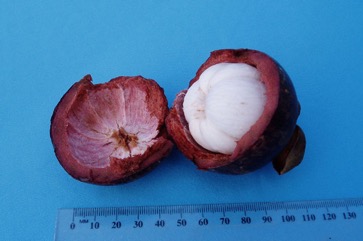
It is a tropical plant. It needs a hot humid climate (25°C to 35°C). Temperatures below 5°C will kill the plant and temperatures below 20°C slow growth. It grows from sea level up to 1000 m altitude in the equatorial tropics although they grow very slowly at this altitude. It can stand light shade. It often does not do well with sea breezes, and needs protection from wind. It cannot tolerate drought. It needs fertile soil. Good fertility enables earlier bearing. It suits high rainfall areas over 2500 mm per year. It cannot tolerate alkaline soils. It needs a pH between 5.5-6.8. It grows between 10°N-10°S. It suits hardiness zones 11-12.
Also known as:
Cay mang-cut, Gamus, Lashai, Manggis, Mangistan, Mangkhud, Mangkhut, Mangkut, Mangostan, Mangostane, Mangostanier, Mangostano, Mangostao, Mangosuchin, Mangus kai, Mangus, Mangusta, Mangustan, Mangut, Masta, Mingut thi, Mongkhut, Mungkud, Ple semeta, Pohon manggis manis, Sulambali
Synonyms
- Mangostana garcinia Gaertner
Edible Portion
- Fruit, Seeds
Where does Mangosteen grow?
Found in: Africa, Andamans, Asia, Australia, Bangladesh, Brazil, Cambodia, Cameroon, Central Africa, Central America, China, Congo DR, Cook Islands, Costa Rica, Cuba, Dominican Republic, East Africa, East Timor, Fiji, Ghana, Haiti, Hawaii, India, Indochina, Indonesia, Jamaica, Laos, Malaysia, Mexico, Myanmar, Nicaragua, North America, Pacific, Palau, Papua New Guinea, PNG, Philippines, Pohnpei, Puerto Rico, Sao Tome and Principe, SE Asia, Singapore, Solomon Islands, South America, Sri Lanka, Suriname, Taiwan, Thailand, Timor-Leste, United States, Vietnam, West Africa, West Indies, Zambia
Notes: There are about 300 Garcinia species. Correct name is probably Garcinia x mangostana L.
Status: It is a cultivated food plant. A few trees have been planted in lowland areas of Papua New Guinea. It is a very popular fruit. It is commercially cultivated.
Growing Mangosteen
Cultivation: Trees breed true from seed because they are produced asexually. This means trees are very uniform. As well some seeds can produce more than one seedling. They germinate between 10 and 54 days. Seeds need to be fresh (less than 5 days after extraction) and undamaged, and cleaned of pulp. They quickly lose their viability. Transplanting is done with care after 2 years. Long tap roots make this difficult. Young trees require shade during hot weather. The slow early growth is because the original roots of the seedling are replaced by new roots from the base of the stem. A spacing of 7 - 10 m suits. Grafting onto vigorous root stocks is difficult. It has been performed on Garcinia tinctoria. Budding, cuttings and layering have been unsuccessful.
Edible Uses: Fruit is best eaten fresh. It is the arillus or layer around the seeds which is eaten. They are also cooked and used in desserts. The seeds are eaten after boiling or roasting. They can be ground to produce a vegetable butter.
Production: Trees are slow growing and begin to bear after 8-20 years. Fruit are produced on shoots which are more than two years old so pruning is unnecessary. Fruiting is seasonal once or twice a year. Often more fruit are produced every second year. The main fruiting season is November to March. Fruit need to be harvested when mature and ripe. Fruit can only be transported with difficulty. They can be stored under refrigeration. (10°C for up to eight weeks). Between 500 to 1500 fruit are produced per tree. Fruit are best opened by cutting the skin around the middle to prevent tannins from the skin spoiling the flavour. Fruit can be stored for 3 weeks if undamaged.
Nutrition Info
per 100g edible portion| Edible Part | Energy (kcal) | Protein (g) | Iron (mg) | Vitamin A (ug) | Vitamin c (mg) | Zinc (mg) | % Water |
|---|---|---|---|---|---|---|---|
| Fruit | 72 | 0.6 | 0.4 | - | 2.7 | - | 81.3 |
Mangosteen Photos

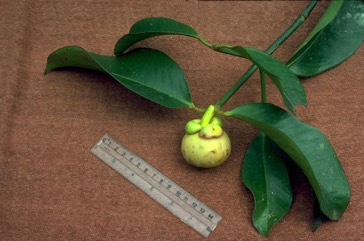
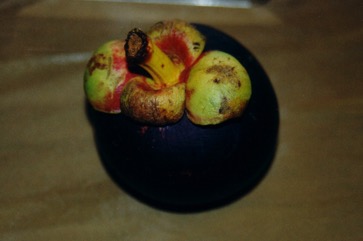
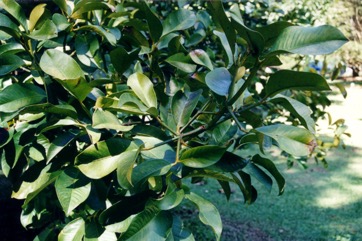
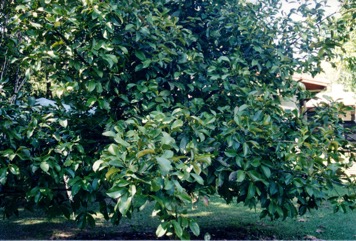
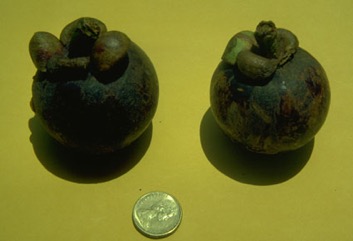
References
Mangosteen references Garcinia mangostana
Abbiw, D.K., 1990, Useful Plants of Ghana. West African uses of wild and cultivated plants. Intermediate Technology Publications and the Royal Botanic Gardens, Kew. p 46
Alain & Martorell. 1982. Flora of Puerto Rico.
Alexander, D.M., Scholefield, P.B., Frodsham, A., 1982, Some tree fruits for tropical Australia. CSIRO, Australia. p 37
Allen, B.M., 1975, Common Malaysian Fruits. Longmans. p
Ambasta, S.P. (Ed.), 2000, The Useful Plants of India. CSIR India. p 230
Arora, R. K., 2014, Diversity in Underutilized Plant Species - An Asia-Pacific Perspective. Bioversity International. p 73
Ashton, M. S., et al 1997, A Field Guide to the Common Trees and Shrubs of Sri Lanka. WHT Publications Ltd. p 148
Backer & Bakhuisen, f. 1963-1968. Flora of Java
Barwick, M., 2004, Tropical and Subtropical Trees. A Worldwide Encyclopedic Guide. Thames and Hudson p 194
Bodkin, F., 1991, Encyclopedia Botanica. Cornstalk publishing, p 485
Brouk, B., 1975, Plants Consumed by Man. Academic Press, London. p 185
Burkill, I.H., 1935, A Dictionary of the Economic Products of the Malay Peninsula. p 1069-1072.
Burkill, H. M., The useful plants of west tropical Africa
Call, C. A., et al, 2004, Participatory Rural Appraisal in the Upland Ecosystem of Mt Malindang, Misamis Occidental, Philippines. Biodiversity Research Programme for Development in Mindanao. p 53
Chai, P. P. K. (Ed), et al, 2000, A checklist of Flora, Fauna, Food and Medicinal Plants. Lanjak Entimau Wildlife Sanctuary, Sarawak. Forestry Malaysia & ITTO. p 166
Chandrashekara, U. M., 2009, Tree species yielding edible fruit in the coffee-based homegardens of Kerala, India: their diversity, uses and management. Food Sec. 1:361-370
Cheifetz, A., (ed), 1999, 500 popular vegetables, herbs, fruits and nuts for Australian Gardeners. Random House p 197
Chin, H.F., & Yong, H.S., 1996, Malaysian Fruits in Colour. Tropical press, Kuala Lumpur
Cobley, L.S.(rev.W.M.Steele),1976, An Introduction to the Botany of Tropical Crops. Longmans. p 187-188.
Coe, F. G. and Anderson, G. J., 1999, Ethnobotany of the Sumu (Ulwa) of Southeastern Nicaragua and Comparisons with Miskitu Plant Lore. Economic Botany Vol. 53. No. 4. pp. 363-386
Coronel, R.E., 1982, Fruit Collections in the Philippines. IBPGR Newsletter p 7
Cundall, P., (ed.), 2004, Gardening Australia: flora: the gardener's bible. ABC Books. p 624
Darley, J.J., 1993, Know and Enjoy Tropical Fruit. P & S Publishers. p 44
Encke, F., et al. 1984. Zander: Handworterbuch der Pflanzennamen, ed. 13.
Engel, D.H., & Phummai, S., 2000, A Field Guide to Tropical Plants of Asia. Timber Press. p 104
Etoh, T. & Sundaresan, 1985, Food Plants in Fiji and Their Utilization. Kagoshima Univ. Res. Center S. Pac, Occasional Papers, No. 5. p. 145-164.
Etherington, K., & Imwold, D., (Eds), 2001, Botanica's Trees & Shrubs. The illustrated A-Z of over 8500 trees and shrubs. Random House, Australia. p 341
Facciola, S., 1998, Cornucopia 2: a Source Book of Edible Plants. Kampong Publications, p 79
Flowerdew, B., 2000, Complete Fruit Book. Kyle Cathie Ltd., London. p 160
Fowler, D. G., 2007, Zambian Plants: Their Vernacular Names and Uses. Kew. p 79
French, B.R., 1986, Food Plants of Papua New Guinea. A Compendium. Papua New Guinea Biological Society. p 267
French, B.R., 2010, Food Plants of Solomon Islands. A Compendium. Food Plants International Inc. p 256
Garner, R.J., and Chaudhri, S.A., (Ed.) 1976, The Propagation of Tropical fruit Trees. FAO/CAB. p 361
Giesen, W., 2013, Paludiculture: sustainable alternatives on degraded peat land in Indonesia (revised draft)
Hackett, C. , & J. Carolane. Edible Horticultural Crops. Academic Press, 1982.
Hearne, D.A., & Rance, S.J., 1975, Trees for Darwin and Northern Australia. AGPS, Canberra p 71
Hedrick, U.P. (ed), 1919, Sturtevant’s Edible Plants of the World. Dover. p 286 (324)
Hibbert, M., 2002, The Aussie Plant Finder 2002, Florilegium. p 108
http://palaeoworks.anu.edu.au/Nuno_PhD/04.pdf re Timor
Hu, Shiu-ying, 2005, Food Plants of China. The Chinese University Press. p 558
INFOODS:FAO/INFOODS Databases
International Seed Testing Association. 1988. International Seed Testing Association list of stabilized plant names.
Jardin, C., 1970, List of Foods Used In Africa, FAO Nutrition Information Document Series No 2.p 139
Johns, L.& Stevenson,V., 1979, The Complete Book of Fruit. Angus and Robertson p 187-188
Keay & Hepper. 1953-1972. Flora of west tropical Africa, ed. 2.
Kiple, K.F. & Ornelas, K.C., (eds), 2000, The Cambridge World History of Food. CUP p 1809
Kunkel, G., Plants for human consumption
Lembaga Biologi Nasional, 1977, Buah-Buahan, Balai Pustaka, Jakarta. p 88
Leon, J., 1968, Fundamentos Botanicos de Los Cultivos Tropicales p 391
Liberty Hyde Bailey Hortorium. 1976. Hortus third.
Li Xi-wen & Li Jie; Peter F. Stevens, Clusiaceae [Draft], Flora of China
Little, E. L., et al, 1974, Trees of Puerto Rico and the Virgin Islands. USDA Handbook 449. Forestry Service. p 566
Lorenzi, H., Bacher, L., Lacerda, M. & Sartori, S., 2006, Brazilian Fruits & Cultivated Exotics. Sao Paulo, Instituto Plantarum de Estuados da Flora Ltda. p 378
Macmillan, H.F. (Revised Barlow, H.S., et al) 1991, Tropical Planting and Gardening. Sixth edition. Malayan Nature Society. Kuala Lumpur. p 281
Maheswari. 1974. Bull. Bot. Surv. India 6:116.
Martin, F. W., et al, 1987, Perennial Edible Fruits of the Tropics. USDA Handbook 642 p 30
Martin, M.A., 1971, Introduction L'Ethnobotanique du Cambodge. Centre National de la Recherche Scientifique. Paris.
McMakin, P.D., 2000, Flowering Plants of Thailand. A Field Guide. White Lotus. p 106
Menninger, E.A., 1977, Edible Nuts of the World. Horticultural Books. Florida p 46
Merrill, 1922-1926. An enumeration of Philippine flowering plants.
Miguel, E., et al, 1989, A checklist of the cultivated plants of Cuba. Kulturpflanze 37. 1989, 211-357
Morton, J. F., 1987, Fruits of Warm Climates. Wipf & Stock Publishers p 301
Morley, B. & Everard, B., 1970, Wild Flowers of the World. Ebury press. Plate 118
Naik, K.C.,1949, South Indian Fruits and their culture, Vanadachary, Madras p 396-403.
Nathan, A., & Wong Y Chee, 1987, A Guide to Fruits and Seeds, Singapore Science Centre. p 54
Norrington, L., & Campbell, C., 2001, Tropical Food Gardens. Bloomings Books. p 108
Ochse, J.J., 1931, Fruits and Fruit Culture in the Dutch East Indies.p 54,
Ochse, J.J., Dijkman, M.J., Soule, M.J. & Wehlburg, C., 1961, Tropical and Subtropical Agriculture. Macmillan.
Owen, S., 1993, Indonesian Food and Cookery, INDIRA reprints. p 73
Partha, P., 2014, Ethnobotany of the Laleng (Patra) Community in Bangladesh. Journal of Pharmacognosy and Phytochemistry. 2(6):173-184
Paul, A., 2013, Minor and uncultivated fruits of Eastern India, 2nd International Symposium on Minor Fruits and Medicinal Plants
Peekel, P.G., 1984, (Translation E.E.Henty), Flora of the Bismarck Archipelago for Naturalists, Division of Botany, Lae, PNG. p 377,
Pham-Hoang Ho, 1999, An Illustrated Flora of Vietnam. Nha Xuat Ban Tre. p 450
Phon, P., 2000, Plants used in Cambodia. © Pauline Dy Phon, Phnom Penh, Cambodia. p 309
Plants of Haiti Smithsonian Institute http://botany.si.edu/antilles/West Indies
PROSEA (Plant Resources of South East Asia) handbook, Volume 2, 1991, Edible fruits and nut. p 177
Purseglove, J.W., 1968, Tropical Crops:Dicotyledons, Longmans. p 633
Rajapaksha, U., 1998, Traditional Food Plants in Sri Lanka. HARTI, Sri Lanka. p 111
Robyns, W., et al., eds.1948-63; Jardin Bot.Natl.Belgique. 1967-. Flore duCongo belge et du Ruanda-Urundi. 1948-63; Flore du Congo,du Rwanda et du Burundi (Flore d'Afrique centrale) 1967-
Ross. Flora of southern Africa.
Rukmana, R., 1995, Manggis, Penerbit Kanisius, Jogyakarta
Sahni, K.C., 2000, The Book of Indian Trees. Bombay Natural History Society. Oxford. p 26
Segura, S., et al, 2018, The edible fruit species in Mexico. Genet Resour Crop Evol (2018) 65:1767–1793
Sharma, B.B., 2005, Growing fruits and vegetables. Publications Division. Ministry of Information and broadcasting. India. p 92
Singh, R., 1969, Fruits. National Book Trust of India. p 124-125
Siong, K. H., 2003, Indigenous Fruits of Sarawak. ITTO & Sarawak Forest Department. p 43
Slik, F., www.asianplant.net
Smith, A.C., 1981, Flora Vitiensis Nova, Lawaii, Kuai, Hawaii, Volume 2 p 347
Smith, P.M., 1979, Mangosteen, in Simmonds, N.W., (ed), Crop Plant Evolution. Longmans. London. p 310
Smith & Darwin. 1974. J. Arnold Arbor. 55:261.
Solomon, C., 2001, Encyclopedia of Asian Food. New Holland. p 231
Sp. pl. 1:443. 1753
St. John, H., 1973. List and summary of the flowering plants in the Hawaiian islands.
Sukarya, D. G., (Ed.) 2013, 3,500 Plant Species of the Botanic Gardens of Indonesia. LIPI p 301
Suwardi, A. B., et al, 2020, Ethnobotany and conservation of indigenous edible fruit plants in South Aceh, Indonesia. Biodiversitas Vol. 21, No. 5, pp 1850-1860
Tankard, G., 1990, Tropical fruit. An Australian Guide to Growing and using exotic fruit. Viking p 76
Tate, D., 1999, Tropical Fruit. Archipelago Press. Singapore. p 62
Terrell et al. 1986. Agric. Handb. no. 505.
Thitiprasert, W., et al, 2007, Country report on the State of Plant Genetic Resources for Food and Agriculture in Thailand (1997-2004). FAO p 95
Turrill et al., eds. 1952-. Flora of tropical East Africa.
USDA, ARS, National Genetic Resources Program. Germplasm Resources Information Network - (GRIN). [Online Database] National Germplasm Resources Laboratory, Beltsville, Maryland. Available: www.ars-grin.gov/cgi-bin/npgs/html/econ.pl (10 April 2000)
Verheij, E. W. M., and R. E. Coronel, eds. 1991. Edible fruits and nuts. In: E. W. M. Verheij & R. E. Coronel (eds.), Plant Resources of South-East Asia (PROSEA). 2:177.
Vivien, J., & Faure, J.J., 1996, Fruitiers Sauvages d'Afrique. Especes du Cameroun. CTA p 131
Tankard, G., 1987, Tropical fruit. Viking. p 76-77.
van Wyk, B., 2005, Food Plants of the World. An illustrated guide. Timber press. p 199
Wickens, G.E., 1995, Edible Nuts. FAO Non-wood forest products. FAO, Rome. p 131
Williams, C.N., Chew, W.Y., and Rajaratnam, J.A., 1989, Tree and Field Crops of the Wetter Regions of the Tropics. Longman, p 132-133.
Woodson & Schery, eds. 1943-1980. Flora of Panama.
World Checklist of Useful Plant Species 2020. Royal Botanic Gardens, Kew
www.worldagroforestrycentre.org/treedb/
Yaacob, O., & S. Subhadrabandhu, Oxford Univ. Press. 1995. The production of economic fruits in South-East Asia.
Zawiah, N. & Othaman, H., 2012, 99 Spesies Buah di FRIM. Institut Penyelidikan Perhutanan Malaysia. p 130